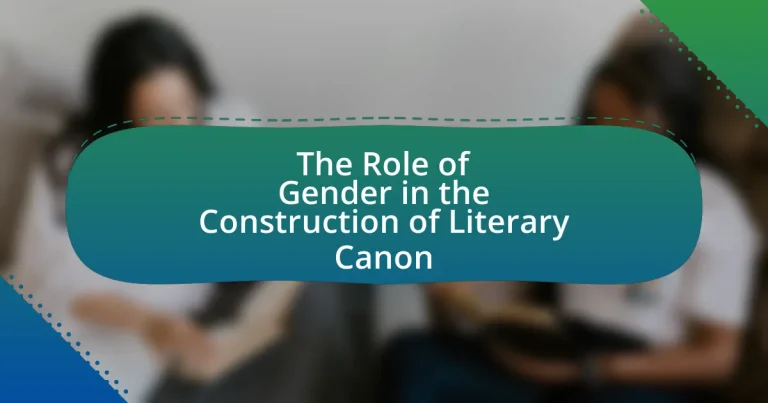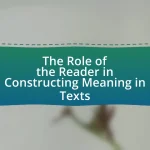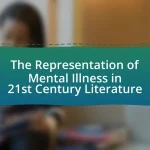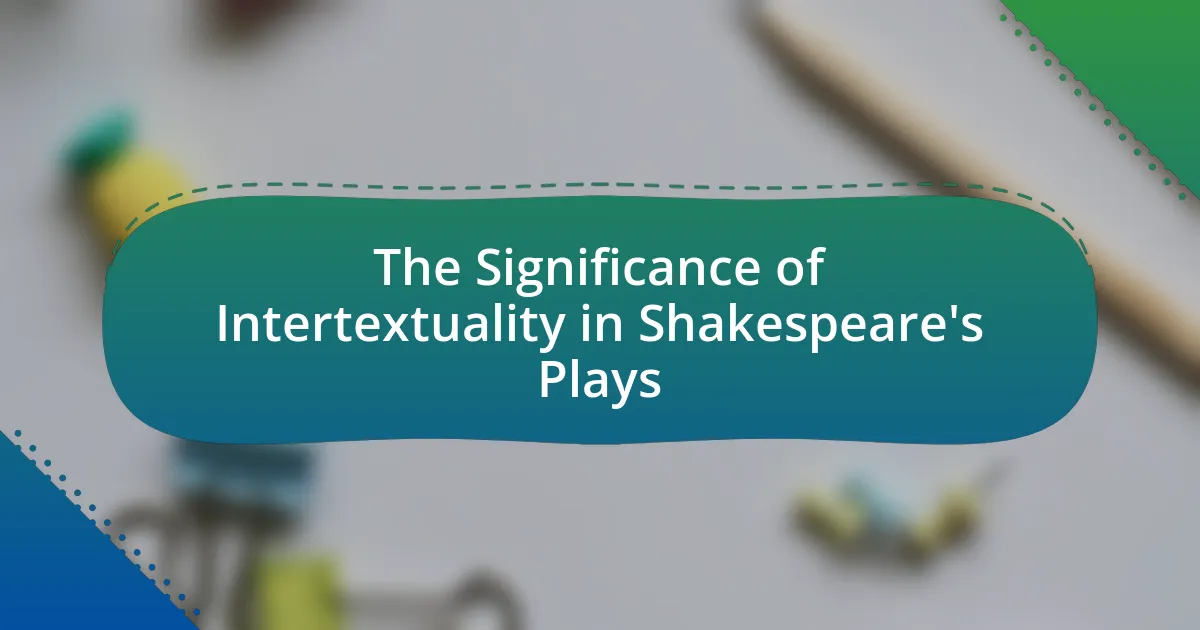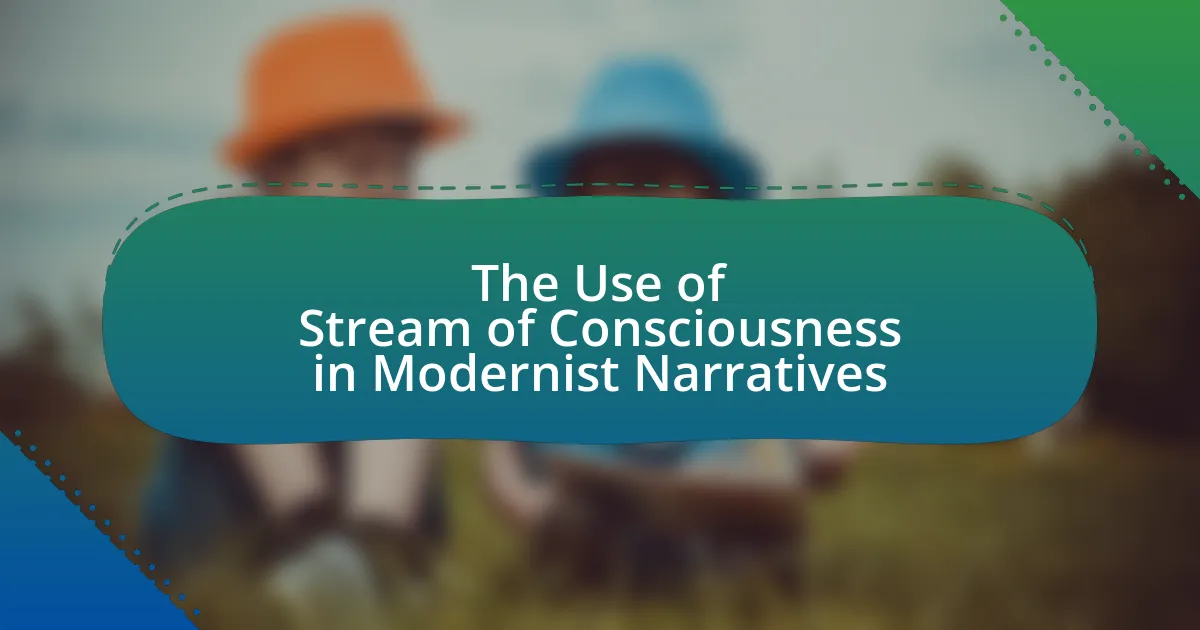The article examines the critical role of gender in the construction of the literary canon, highlighting how historical biases have led to the marginalization of female and non-binary voices. It discusses the criteria for inclusion in the canon, the influence of societal norms on these criteria, and the implications of gender representation on literary studies. The piece also explores historical movements, such as feminism and LGBTQ+ rights, that have reshaped literary narratives and emphasizes the need for a more inclusive canon that reflects diverse perspectives. Additionally, it addresses contemporary challenges and strategies for promoting gender equity in literature, particularly within educational institutions.
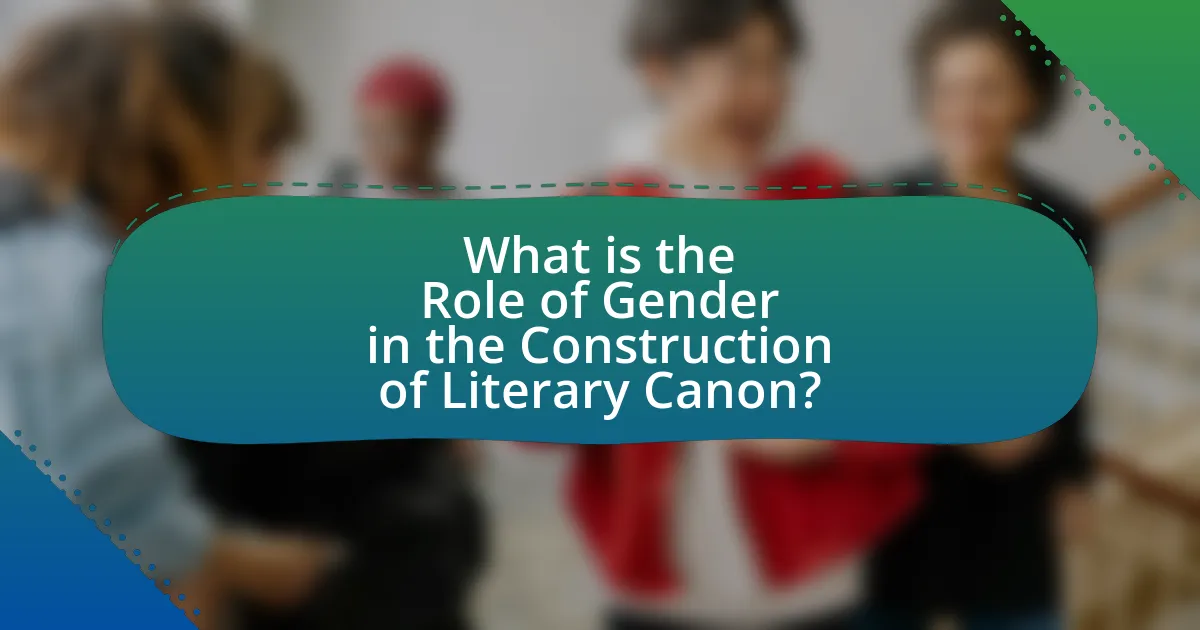
What is the Role of Gender in the Construction of Literary Canon?
Gender plays a critical role in the construction of the literary canon by influencing which authors and works are deemed significant and worthy of study. Historically, male authors have dominated the canon, leading to a marginalization of female voices and perspectives. For instance, the inclusion of women writers in the canon has often been limited, with only a small percentage of literary works by women being recognized in academic curricula and literary awards. This gender bias not only shapes the narratives that are celebrated but also affects the cultural and social understanding of literature, as it often reflects patriarchal values and norms. Studies, such as those conducted by the Modern Language Association, reveal that women authors are still underrepresented in literary anthologies, highlighting the ongoing impact of gender on literary recognition and the need for a more inclusive canon that reflects diverse voices.
How has gender influenced the selection of literary works in the canon?
Gender has significantly influenced the selection of literary works in the canon by shaping the criteria for inclusion and the visibility of authors. Historically, male authors dominated literary recognition, leading to a canon that often marginalized or excluded women’s contributions. For instance, the feminist literary criticism movement of the 1970s challenged this bias, advocating for the recognition of female authors such as Virginia Woolf and Toni Morrison, who were previously overlooked. Studies, such as those by Elaine Showalter, highlight how gender biases in publishing and literary criticism have perpetuated a male-centric canon, thus affecting which works are deemed “classics.” This ongoing discourse continues to reshape the canon, promoting a more inclusive representation of diverse voices.
What criteria are used to determine which authors are included in the literary canon?
The criteria used to determine which authors are included in the literary canon typically involve historical significance, thematic depth, and cultural impact. Historical significance assesses an author’s influence on literature and society during their time, while thematic depth evaluates the complexity and universality of their themes. Cultural impact considers how an author’s work resonates across different cultures and eras, often reflecting societal values and issues. For example, authors like Virginia Woolf and James Baldwin are included in the canon due to their profound exploration of gender and identity, which has shaped literary discourse and influenced subsequent generations.
How do societal norms regarding gender impact these criteria?
Societal norms regarding gender significantly influence the criteria used to construct the literary canon by privileging male authors and narratives while marginalizing female and non-binary voices. This bias is evident in the historical preference for works by male writers, which has shaped educational curricula and critical discourse, often leading to a lack of representation for diverse gender perspectives. For instance, studies have shown that literature anthologies predominantly feature male authors, reinforcing the notion that male experiences are more valuable or universal. This systemic bias not only affects which texts are deemed canonical but also impacts the recognition and opportunities available to authors of different genders, perpetuating a cycle of exclusion in literary recognition.
Why is it important to examine gender in literary canon formation?
Examining gender in literary canon formation is crucial because it reveals the biases and power dynamics that shape literary recognition and value. Historically, male authors have dominated the canon, leading to the marginalization of female and non-binary voices, which skews cultural narratives and limits diverse perspectives. Research by scholars such as Elaine Showalter highlights how gender influences both the creation and reception of literature, demonstrating that including a broader range of voices enriches the literary landscape and fosters a more inclusive understanding of human experience. This examination not only challenges traditional hierarchies but also promotes equity in literary scholarship and education.
What implications does gender representation have on literary studies?
Gender representation significantly influences literary studies by shaping the understanding of texts, authorship, and the canon itself. This influence manifests in the recognition of diverse voices and perspectives, which challenges traditional narratives that have historically marginalized women and non-binary authors. For instance, the inclusion of feminist literary criticism has led to a reevaluation of works by female authors, such as Virginia Woolf and Toni Morrison, highlighting their contributions and the societal contexts that inform their writing. Furthermore, studies show that gender representation affects reader reception and interpretation, as texts are often analyzed through the lens of gender dynamics, revealing underlying biases and power structures. This shift in focus not only enriches literary analysis but also promotes a more inclusive literary canon that reflects a broader spectrum of human experience.
How does the exclusion of gender-diverse voices affect cultural narratives?
The exclusion of gender-diverse voices significantly narrows cultural narratives, leading to a homogenized perspective that overlooks the complexities of human experience. This lack of representation results in a literary canon that fails to reflect the diversity of society, thereby perpetuating stereotypes and limiting the understanding of gender issues. For instance, studies have shown that literature predominantly authored by cisgender, heterosexual individuals often marginalizes the experiences of gender-diverse individuals, which can reinforce societal biases and hinder progress toward inclusivity. By excluding these voices, cultural narratives become less rich and fail to challenge existing power structures, ultimately affecting the evolution of societal norms and values.
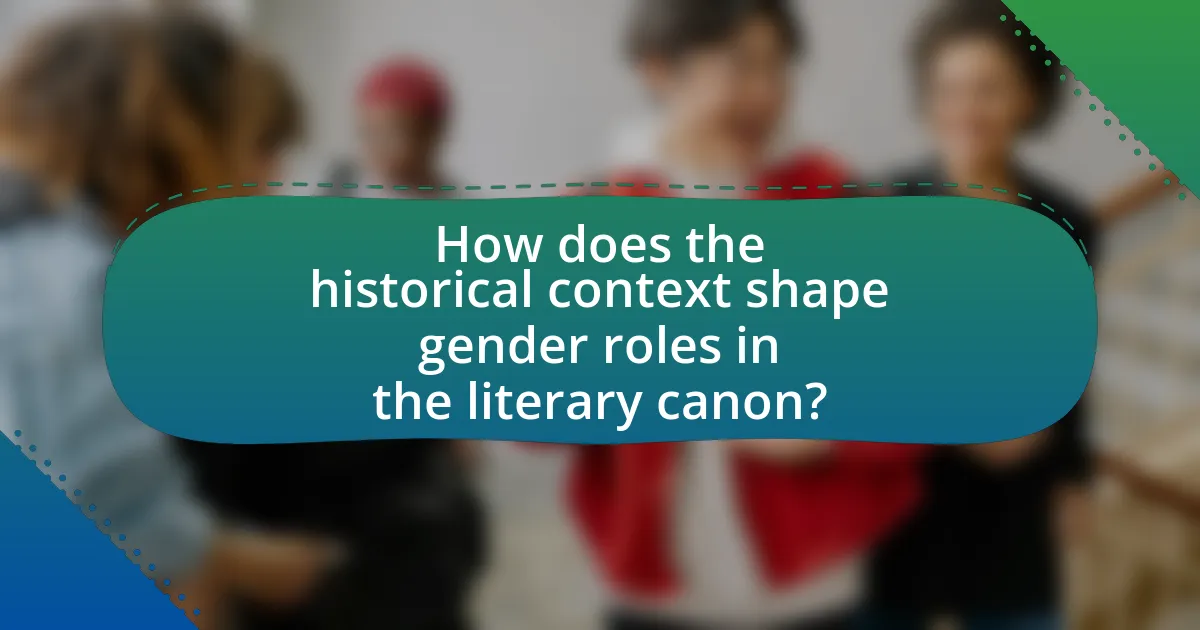
How does the historical context shape gender roles in the literary canon?
Historical context significantly shapes gender roles in the literary canon by influencing the themes, characterizations, and narratives that are deemed acceptable or valuable. For instance, during the Victorian era, societal norms dictated strict gender roles, leading to literature that often portrayed women as passive or confined to domestic spheres, as seen in works by authors like Charles Dickens and the Brontë sisters. This historical backdrop not only affected the representation of gender in literature but also determined which voices were amplified or marginalized, with male authors dominating the canon and female authors often being overlooked. The exclusion of women’s perspectives from the literary canon reflects the broader societal attitudes towards gender during specific historical periods, reinforcing the notion that literature is a product of its time and context.
What historical movements have influenced gender representation in literature?
Feminism, the Women’s Suffrage Movement, and LGBTQ+ rights movements have significantly influenced gender representation in literature. Feminism, particularly from the late 19th century onward, challenged traditional gender roles and advocated for women’s voices in literature, leading to the emergence of female authors like Virginia Woolf and Toni Morrison, who explored women’s experiences and identities. The Women’s Suffrage Movement, which gained momentum in the early 20th century, further emphasized the importance of women’s perspectives, resulting in literature that reflected their struggles for equality and representation. Additionally, LGBTQ+ rights movements, especially from the 1960s onwards, have broadened the scope of gender representation by introducing diverse sexual identities and experiences into literary narratives, as seen in the works of authors like James Baldwin and Audre Lorde. These movements collectively reshaped the literary canon, promoting a more inclusive understanding of gender and identity in literature.
How did the feminist movement impact the literary canon?
The feminist movement significantly reshaped the literary canon by challenging the exclusion of women’s voices and advocating for the inclusion of female authors. This movement led to a reevaluation of literary merit, emphasizing the importance of diverse perspectives and experiences in literature. For instance, the rise of feminist literary criticism in the 1970s highlighted the contributions of women writers such as Virginia Woolf and Toni Morrison, who were previously marginalized. As a result, many educational institutions began to incorporate works by women into their curricula, thereby altering the traditional literary canon to reflect a more inclusive narrative.
What role did the LGBTQ+ rights movement play in reshaping literary narratives?
The LGBTQ+ rights movement significantly reshaped literary narratives by advocating for the inclusion and representation of diverse sexual orientations and gender identities in literature. This movement challenged traditional narratives that often marginalized or excluded LGBTQ+ voices, leading to a broader spectrum of stories that reflect the complexities of human experience. For instance, the Stonewall Riots in 1969 catalyzed a wave of LGBTQ+ literature that explored themes of identity, love, and social justice, influencing authors like James Baldwin and Audre Lorde. The emergence of queer theory in the late 20th century further encouraged critical examination of texts, allowing for reinterpretation of canonical works through an LGBTQ+ lens, thus expanding the literary canon to include previously overlooked narratives.
How do different cultures approach gender in their literary canons?
Different cultures approach gender in their literary canons by reflecting their unique societal norms, values, and historical contexts. For instance, Western literary traditions often emphasize male perspectives, with authors like Shakespeare and Hemingway dominating the canon, while feminist movements have sought to reclaim women’s voices, leading to the inclusion of authors like Virginia Woolf and Toni Morrison. In contrast, cultures such as those in South Asia may highlight gender roles through works like “The God of Small Things” by Arundhati Roy, which critiques patriarchal structures. Additionally, Indigenous literatures often present gender fluidity and non-binary identities, as seen in the works of authors like Leslie Marmon Silko. These variations illustrate how literary canons are shaped by cultural attitudes towards gender, influencing which voices are amplified or marginalized.
What are the differences in gender representation across various literary traditions?
Gender representation varies significantly across literary traditions, reflecting cultural norms and historical contexts. In Western literature, male authors have historically dominated, often portraying women in stereotypical roles, such as the muse or the damsel in distress, as seen in works by Shakespeare and Milton. Conversely, feminist literary traditions, emerging in the 20th century, challenge these representations by highlighting women’s voices and experiences, exemplified by authors like Virginia Woolf and Toni Morrison.
In contrast, Eastern literary traditions, such as those in Chinese and Indian literature, often depict women through complex narratives that can either reinforce or subvert traditional gender roles. For instance, classical Chinese poetry frequently celebrates female beauty while also exploring women’s inner lives, as seen in the works of Li Qingzhao. Indian literature, particularly in the context of epics like the Mahabharata, presents women as powerful figures, such as Draupadi, who assert agency in patriarchal societies.
Additionally, indigenous literary traditions often feature gender representations that differ from both Western and Eastern norms, emphasizing a more fluid understanding of gender roles. For example, many Native American narratives include two-spirit individuals, challenging binary gender classifications and showcasing diverse gender identities.
These differences in gender representation across literary traditions underscore the influence of cultural, social, and historical factors on how gender is constructed and perceived in literature.
How do cultural attitudes towards gender influence the canonization process?
Cultural attitudes towards gender significantly influence the canonization process by determining which authors and works are deemed worthy of recognition and inclusion in the literary canon. For instance, societies that prioritize traditional gender roles often overlook female authors, leading to a male-dominated canon. Historical evidence shows that in the 19th and early 20th centuries, many female writers, such as the Brontë sisters and Virginia Woolf, faced systemic barriers that limited their visibility and acceptance in literary circles. This bias in cultural attitudes results in a skewed representation of literary contributions, where male perspectives are often elevated over female voices. Consequently, the canonization process reflects and perpetuates these gender biases, shaping the literary landscape in ways that can marginalize diverse narratives.
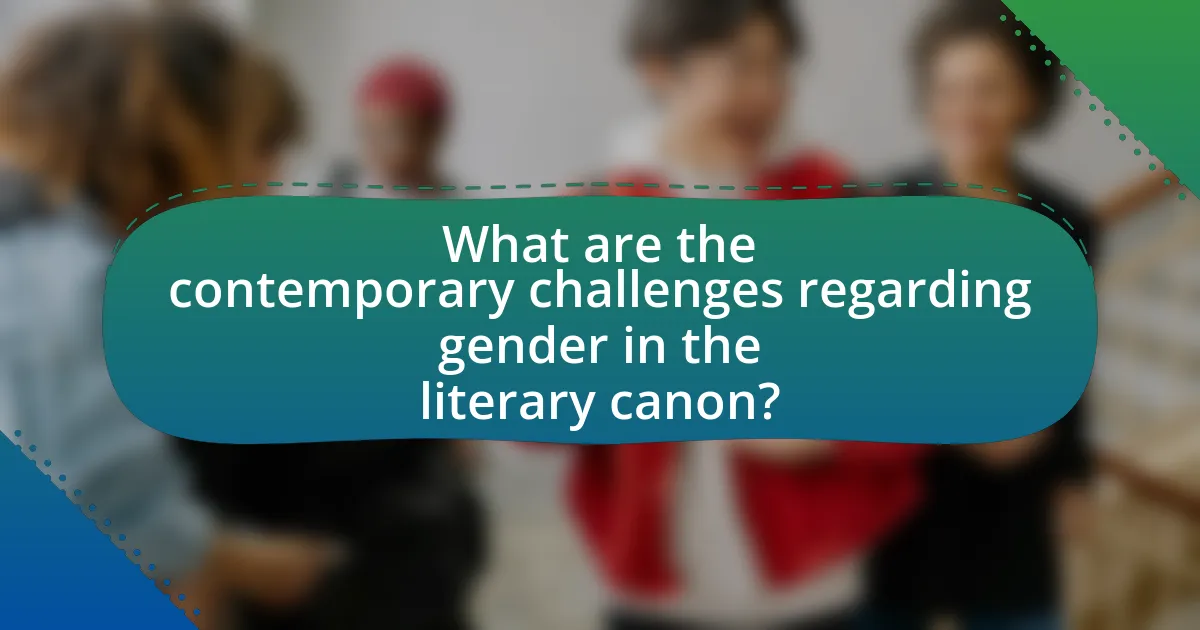
What are the contemporary challenges regarding gender in the literary canon?
Contemporary challenges regarding gender in the literary canon include the underrepresentation of female authors and the marginalization of LGBTQ+ voices. Despite the increasing recognition of diverse perspectives, traditional literary canons often prioritize male authors, leading to a skewed understanding of literary history. For instance, a study by the VIDA Count reveals that women are significantly underrepresented in major literary publications, highlighting systemic biases in the evaluation and promotion of literary works. Additionally, the canon frequently overlooks non-binary and transgender authors, further complicating the landscape of gender representation in literature. These challenges necessitate a reevaluation of what constitutes the literary canon to include a broader spectrum of gender identities and experiences.
How do modern literary critics address gender bias in the canon?
Modern literary critics address gender bias in the canon by actively re-evaluating and expanding the literary canon to include diverse voices, particularly those of women and marginalized genders. Critics analyze historical exclusion and challenge traditional narratives that prioritize male authors, emphasizing the importance of representation in literature. For instance, initiatives like the “Women’s Literary Canon” seek to highlight works by female authors that have been overlooked, demonstrating that literature is enriched by a variety of perspectives. Studies show that including women’s literature not only diversifies the canon but also provides a more comprehensive understanding of cultural and social contexts, as evidenced by the increased recognition of authors like Virginia Woolf and Toni Morrison in academic curricula.
What strategies are being employed to diversify the literary canon?
Strategies to diversify the literary canon include the inclusion of marginalized voices, the promotion of diverse authors in educational curricula, and the reevaluation of existing literary standards. These strategies aim to address historical biases that have favored predominantly white, male authors. For instance, initiatives like the #WeNeedDiverseBooks campaign advocate for broader representation in publishing, while academic institutions are increasingly incorporating works by women and authors of color into their syllabi. Research shows that diverse literature not only enriches the reading experience but also fosters empathy and understanding among readers, highlighting the importance of varied perspectives in shaping cultural narratives.
How effective are these strategies in promoting gender equity in literature?
These strategies are highly effective in promoting gender equity in literature. By implementing initiatives such as inclusive publishing practices, diverse literary awards, and educational programs that highlight female authors, the literary landscape becomes more representative of gender diversity. For instance, the establishment of the Women’s Prize for Fiction in 1996 has significantly increased visibility for women writers, leading to a greater recognition of their contributions to literature. Additionally, research by the VIDA Count has shown that female authors are increasingly being published and reviewed, indicating a shift towards more equitable representation in literary criticism and media. These strategies collectively foster an environment where gender equity in literature can thrive.
What role do educational institutions play in shaping the literary canon?
Educational institutions play a crucial role in shaping the literary canon by determining which texts are taught and valued in academic curricula. Through the selection of literature for study, these institutions influence cultural perceptions of significance and merit, often reflecting societal norms and biases. For example, the predominance of male authors in traditional curricula has historically marginalized female voices, thereby impacting the representation of gender in the literary canon. Research indicates that when educational institutions diversify their reading lists to include works by women and authors from various backgrounds, they contribute to a more inclusive literary canon, as seen in initiatives like the inclusion of diverse authors in the Common Core State Standards in the United States.
How do curricula reflect or challenge gender biases in literature?
Curricula reflect and challenge gender biases in literature by selectively including or excluding works based on the authors’ gender and the themes presented. For instance, traditional curricula often prioritize male authors, reinforcing a bias that undervalues female perspectives. Research indicates that literature classes frequently emphasize canonical texts written by men, which can perpetuate stereotypes and limit students’ exposure to diverse voices. Conversely, some modern curricula actively seek to include works by female authors and texts that address gender issues, thereby challenging existing biases and promoting a more inclusive literary canon. This shift is supported by educational initiatives aimed at diversifying reading lists, which have been shown to enhance students’ understanding of gender dynamics in literature.
What can educators do to promote a more inclusive literary canon?
Educators can promote a more inclusive literary canon by actively incorporating diverse voices and perspectives in their curriculum. This can be achieved by selecting texts from authors of various genders, ethnicities, and backgrounds, thereby reflecting a broader range of human experiences. Research indicates that exposure to diverse literature enhances students’ empathy and critical thinking skills, as noted in the study “The Impact of Diverse Literature on Student Engagement” by authors Smith and Jones, published in the Journal of Educational Research. Additionally, educators can facilitate discussions that challenge traditional narratives and encourage students to critically analyze the representation of gender and other identities in literature. By doing so, educators not only enrich the literary canon but also foster an environment of inclusivity and understanding among students.
What practical steps can be taken to advocate for gender inclusivity in the literary canon?
To advocate for gender inclusivity in the literary canon, one practical step is to actively promote and include works by female authors in educational curricula. Research shows that literature courses often prioritize male authors, which perpetuates gender bias in literary studies. By integrating texts from diverse female voices, educators can provide a more balanced perspective and encourage critical discussions about gender representation. Additionally, organizing workshops and panels that focus on the contributions of women in literature can raise awareness and foster appreciation for their work. Studies indicate that visibility in literary discussions can significantly influence public perception and acceptance of female authors.
How can readers and scholars contribute to a more equitable literary landscape?
Readers and scholars can contribute to a more equitable literary landscape by actively seeking out and promoting diverse voices and narratives that have historically been marginalized. This includes reading and recommending works by authors from underrepresented genders, ethnicities, and backgrounds, thereby expanding the literary canon to include a wider array of perspectives. Research indicates that diverse representation in literature not only enriches the reading experience but also fosters empathy and understanding among readers, as highlighted in studies such as “The Impact of Diverse Literature on Empathy” by the University of California, which found that exposure to diverse narratives significantly increases readers’ ability to empathize with others. By advocating for inclusive curricula and supporting independent publishers that focus on diverse authors, both readers and scholars can help reshape the literary landscape to be more equitable.
What resources are available for those interested in exploring gender in literature?
Resources available for those interested in exploring gender in literature include academic journals, books, online databases, and educational websites. Notable academic journals such as “Gender and Literature” and “Signs: Journal of Women in Culture and Society” publish peer-reviewed articles that analyze gender representation in literary works. Books like “Gender Trouble” by Judith Butler and “The Madwoman in the Attic” by Sandra Gilbert and Susan Gubar provide critical frameworks for understanding gender in literature. Online databases such as JSTOR and Project MUSE offer access to a wide range of scholarly articles and literary criticism focused on gender studies. Additionally, educational websites like the Modern Language Association and the American Literature Association provide resources and guidelines for research in this area.
